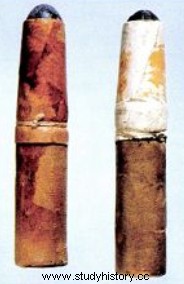
Despite a very short career (only seven years, from 1867 to 1874), almost 150 years after its abandonment, the name "Chassepot" is still present in everyone's mind:it alone evokes the bloody and heroic battles of the Franco-Prussian War of 1870.
The Chassepot rifle (from the name of its creator) or more exactly the 1866 model rifle, is also remarkable in more ways than one:it is the first rifle in Europe to benefit from new mass-produced industrialized production techniques; it is also the first modern breech-loading rifle, and it already has the familiar silhouette of bolt-action weapons and loading by direct introduction of the cartridge into the chamber, such as they will then exist until our days without big changes.
Equipped with a paper cartridge (see below), the Chassepot is a “needle gun”. The striker contained in a cylinder head with rectilinear translation, is a thin steel needle which, when the trigger is lowered by the action of the finger on the trigger tail, is propelled forward under the action of a spring with sausage then perforates the paper cartridge to strike the internal primer.

The so-called "bolt" movable bolt has its front fitting in the rear of the receiver, the absence of a sealing plug means that spitting of gas towards the rear is inevitable. The genius of Chassepot consists in remedying this inconvenience in the simplest possible way:a rubber washer placed at the top of the bolt carrier crashes on the perimeter of the receiver when the bolt head moves back under the pressure. gases at the start of the shot. Provided that the puck is in good condition, and that the rubber has not become brittle, the obturation is total at the start of the shot and, apart from this precise moment, the shooter does not have to make any particular effort to open or close the slide which slides freely along its entire route in its case.
Contrary to the posterior weapons whose breech comprises a helical ramp of armament, the opening is done in two stages; you must first pull the crest of the hammer back with your thumb to then be able to open the breech, this is a survival of the principle of earlier weapons where you also had to cock the hammer with your thumb.
The breech has a safety position; after loading, simply raise the operating lever to 45°, then bring the rear part forward while pressing the trigger, the loaded weapon is then unable to fire. To be able to fire, simply cock the hammer again by pulling it back, and lower the operating lever.
Features (for Infantry Rifle):
Overall length :1,310 m.
Barrel length :0.797 m.
Caliber :11 mm, barrel striped with 4 stripes on the left at a step of 0.55m.
Weight :4.1 kg.
Step rear sight for distances of 200, 300, 350 and 400 meters and with graduated board from 500 to 1200 meters. Goal in white at 150 meters.
Steel cleaning rod.
Sabre-bayonet model 1866 (inspired by the model 1842) with so-called "yatagan" blade .

The Model 1866 cartridge basically consists of a 25 gram lead bullet, a 5.5 gram load of black powder and a fulminate primer. A powder case, made of paper covered with silk gauze, carries the primer at its base. A cardboard washer closes the case at the top; the ball held in a rolled and glued paper cone is placed on the case so that it rests on the puck. The assembly is then tied with a wire that goes around twice a little below the washer.
The ammunition thus produced was, of course, very fragile. To overcome this, the cartridges were carefully packed by 9 in small cardboard boxes. These boxes were opened at the last moment by the shooter, who had to take great care to introduce the cartridge gently into the chamber, after making sure that the latter was not too dirty, and therefore narrowed, by the residues from the shots. previous.

